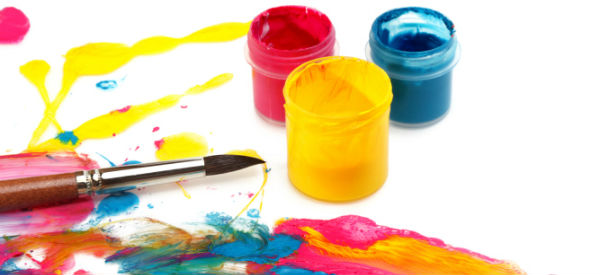
More, Therapy Tips 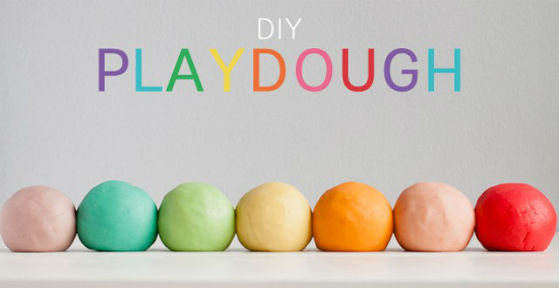 Classic dough is fun on its own, but there is also a variety of ways to change it up by adding color, glitter, and even essential oils to give it a unique smell. Look around the house for creative tools to use with the dough: toy creatures and vehicles, straws, rolling pins, plastic knives, scissors, pizza cutters, pine cones and other natural materials, cookie cutters, pasta, shells, buttons, glass pebbles, wooden letters and numbers, fabric, netting, ribbons…the list is endless.
Here is a basic recipe for play dough:
Ingredients:
Classic dough is fun on its own, but there is also a variety of ways to change it up by adding color, glitter, and even essential oils to give it a unique smell. Look around the house for creative tools to use with the dough: toy creatures and vehicles, straws, rolling pins, plastic knives, scissors, pizza cutters, pine cones and other natural materials, cookie cutters, pasta, shells, buttons, glass pebbles, wooden letters and numbers, fabric, netting, ribbons…the list is endless.
Here is a basic recipe for play dough:
Ingredients:
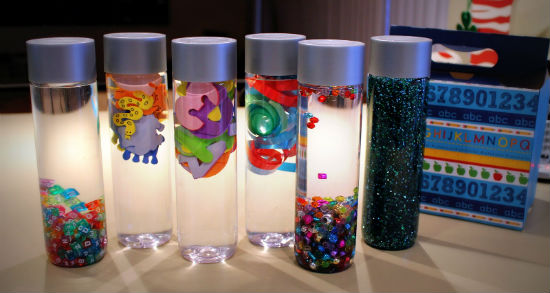 Source: sharronkrull.com Image Credit: The Jandernal Journal
Source: sharronkrull.com Image Credit: The Jandernal Journal
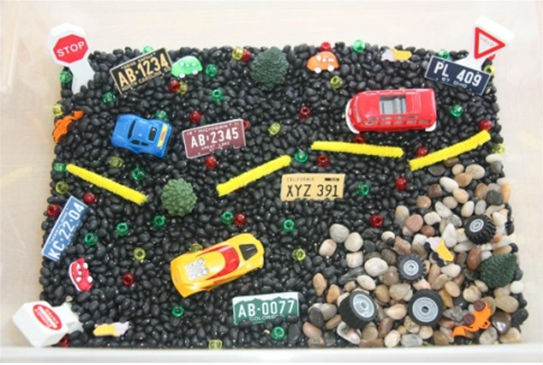 Inside: black beans, river pebbles, small wooden signs (from a train set), die cast cars, plastic trees, red, green, and yellow pony beads (think traffic lights), tires from a Lego set, cut-up pipe cleaners (think of the yellow lines on a street), small car and truck buttons, cut outs of license plates from various US states.
Inside: black beans, river pebbles, small wooden signs (from a train set), die cast cars, plastic trees, red, green, and yellow pony beads (think traffic lights), tires from a Lego set, cut-up pipe cleaners (think of the yellow lines on a street), small car and truck buttons, cut outs of license plates from various US states.
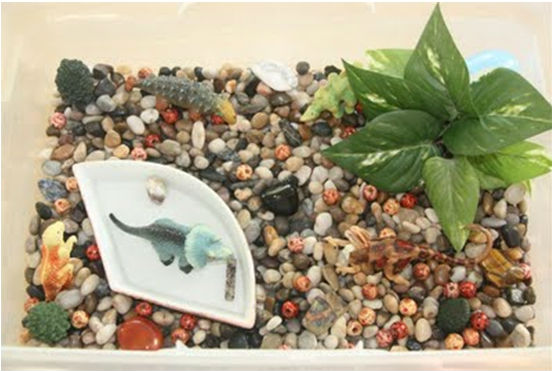 Inside: river pebbles (found in craft and home décor stores), gemstones, artificial leaves, plastic dinosaur toys, mini trees, a small dish with water, plastic eggs containing smaller dinos (see it hiding behind the leaves?), wooden beads.
Inside: river pebbles (found in craft and home décor stores), gemstones, artificial leaves, plastic dinosaur toys, mini trees, a small dish with water, plastic eggs containing smaller dinos (see it hiding behind the leaves?), wooden beads.
Why Children With Special Needs Should Get Messy!
When it comes to play, most parents’ first reaction is to keep it as tidy as possible. With children in the house, we have no choice but to surrender to a certain amount of mess, but the last thing we want to do is clean “gak” out of our carpets. However, allowing a child to have opportunities for messy play is an incredibly important part of development.The Benefits Of Messy Play
Infants begin using their tactile sense (touch) the moment they are born, sucking on a thumb or bottle for self-calming. As babies begin to crawl and explore their environment, their tactile sense begins to become more refined. Lack of ample opportunities to engage in a variety of tactile experiences can cause delays in a child's perception of the world. Without sensory stimulation our brains cannot grow and develop; it is an important part of physical development, just as the opportunity for stacking, pouring, stirring furthers hand-eye coordination.Digging in to the world around us
Messy play teaches concepts such as rough, smooth, soft and hard and helps provide a foundation for a child's own personal sense of space. It also further promotes communication, prompting children to ask for tools and materials and to talk about their finished projects. This type of play gives children a way to express themselves in a very unique manner, as there is no right or wrong way to get messy. Here are some ideas for sensational sensory play:Play Dough
 Classic dough is fun on its own, but there is also a variety of ways to change it up by adding color, glitter, and even essential oils to give it a unique smell. Look around the house for creative tools to use with the dough: toy creatures and vehicles, straws, rolling pins, plastic knives, scissors, pizza cutters, pine cones and other natural materials, cookie cutters, pasta, shells, buttons, glass pebbles, wooden letters and numbers, fabric, netting, ribbons…the list is endless.
Here is a basic recipe for play dough:
Ingredients:
Classic dough is fun on its own, but there is also a variety of ways to change it up by adding color, glitter, and even essential oils to give it a unique smell. Look around the house for creative tools to use with the dough: toy creatures and vehicles, straws, rolling pins, plastic knives, scissors, pizza cutters, pine cones and other natural materials, cookie cutters, pasta, shells, buttons, glass pebbles, wooden letters and numbers, fabric, netting, ribbons…the list is endless.
Here is a basic recipe for play dough:
Ingredients:
- 1 cup water, cold
- 1 cup table salt
- 2 teaspoons canola oil
- 2 ½ cups all-purpose flour
- 2 tablespoons cornstarch
- Food coloring
- In a large mixing bowl, stir together the water, salt and oil.
- Add a few drops of food coloring at this point.
- In a separate medium mixing bowl, sift together the flour and cornstarch.
- Add a half cup of dry ingredients at a time to the wet ingredients, mixing thoroughly with each addition.
- With cornstarch on your hands, knead the play dough until the right consistency is obtained.
- Store in a zip-top bag.
Sensory bottles or bags
 Source: sharronkrull.com Image Credit: The Jandernal Journal
Source: sharronkrull.com Image Credit: The Jandernal Journal
- Fill clear zip-top bags or bottles from soda or sport drinks with a liquid (water, corn syrup, even hair gel).
- Add small items like letters, pebbles, marbles, and glitter.
- Hot glue the lid on to keep the messy stuff intact.
Sensory bins
Create a larger sensory space using a storage tub or even a wading pool. Add in a “filler” material, such as black beans, rice, small pebbles or popcorn, and start adding fun objects for your child to find. Here are few ideas for themes, courtesy of the Counting Coconut Blog:Transportation
 Inside: black beans, river pebbles, small wooden signs (from a train set), die cast cars, plastic trees, red, green, and yellow pony beads (think traffic lights), tires from a Lego set, cut-up pipe cleaners (think of the yellow lines on a street), small car and truck buttons, cut outs of license plates from various US states.
Inside: black beans, river pebbles, small wooden signs (from a train set), die cast cars, plastic trees, red, green, and yellow pony beads (think traffic lights), tires from a Lego set, cut-up pipe cleaners (think of the yellow lines on a street), small car and truck buttons, cut outs of license plates from various US states.
Dinosaurs
 Inside: river pebbles (found in craft and home décor stores), gemstones, artificial leaves, plastic dinosaur toys, mini trees, a small dish with water, plastic eggs containing smaller dinos (see it hiding behind the leaves?), wooden beads.
Inside: river pebbles (found in craft and home décor stores), gemstones, artificial leaves, plastic dinosaur toys, mini trees, a small dish with water, plastic eggs containing smaller dinos (see it hiding behind the leaves?), wooden beads.



